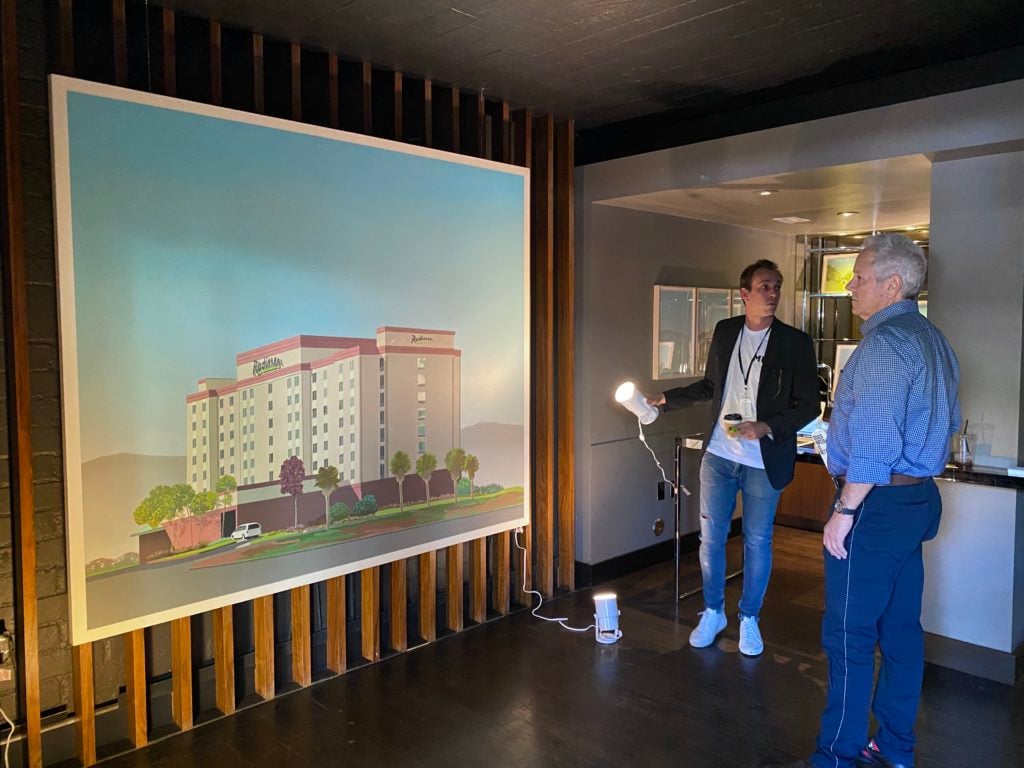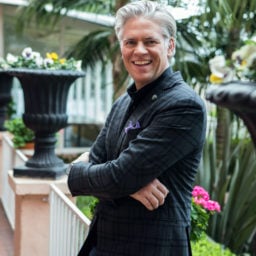Spoiler alert: covering an art fair when you’re tagging alongside a collector with a known pedigree and boundless energy is an entirely different experience than when you’re roaming the aisles with nothing but a notebook and a need to momentarily charm your way into dealers’ good graces.
This became apparent shortly after I met David Hoberman in the lobby of the Hollywood Roosevelt Hotel in the opening minutes of the Felix art fair’s buzzy 2020 edition. Over the next two-plus hours, we would tear through all three levels of the event and the lion’s share of its 63 exhibitors, as well as some of its assorted special projects. What the odyssey would highlight isn’t just that sought-after collectors enjoy tremendous access to information and miscellaneous perks; but also that art fairs are crucial checkpoints in dozens of ongoing relationships between buyer and seller, with individual exchanges often being as much about past and future business as about transactions in the here and now.
Outside the art-world bubble, Hoberman is best known as a prolific feature-film and TV producer. His Hollywood story is a classic. After starting off in the mailroom at ABC, Hoberman climbed through the ranks to become the head of the Motion Picture Group at Disney, then lit out on his own soon after. In 1995, he founded Mandeville Films (now Mandeville Films & Television), whose slate has since earned over $2.5 billion in domestic box office revenue; multiple Oscar wins for films like the 2011 reboot of family sensation The Muppets and David O. Russell’s 2010 boxing drama The Fighter; and a series of first-look deals with Disney that have stretched past the two-decade mark.
On this morning, though, Hoberman’s studio-backlot bona fides felt like more of a burden than a blessing. “I’ve had this day blocked out on my calendar for two months, and now I have a three-hour meeting in Burbank at 2:30,” he lamented shortly after we shook hands. The last-minute scheduling conflict meant he would have to completely abandon his plans to follow up Felix with a visit to Frieze. But despite being forced to choose between the fairs, there was no hesitation as to where he would spend those precious few pre-meeting hours.
As we ducked into the Roosevelt’s ground-floor diner and bar for coffee to-go, Hoberman explained that he first met his close friend (and Felix cofounder) Dean Valentine when they were both working at Disney roughly 30 years ago. Hoberman was beginning to get interested in collecting art, but he didn’t have any formal training in the field and wasn’t sure where to begin.
“Dean gave me about 25 books,” Hoberman said. “It was a way to start training my eye.”
Hoberman went on to build a collection focused on mid-century American modernism, headlined by artists including Fairfield Porter and Alex Katz. But nearly a decade into the journey, he hit a life-changing snag. “I wanted to buy a [Richard] Diebenkorn painting, and I just couldn’t afford it,” he said. “Dean said, ‘Why don’t you start collecting contemporary art?’”
Hoberman took his friend’s advice—and perhaps took it further and faster than either one anticipated. Soon after pivoting to the new genre, he sold nearly his entire collection of modernism and poured the proceeds into collecting contemporary. A handful of holdovers aside, he’s never looked back. The metaphor he conjured when describing his obsession with new works could be interpreted as either medicinal or addictive. He trailed off, chuckling at himself, saying, “Dean stuck the needle so far up my arm…”
A moment later, the coffee arrived, and we headed to the Roosevelt’s service elevator—so far, devoid of any line at all, let alone the seemingly interminable one that riled guests and exhibitors alike at the 2019 edition of the fair—to blast our way up to the exhibitors on the hotel’s 11th and 12th floors.
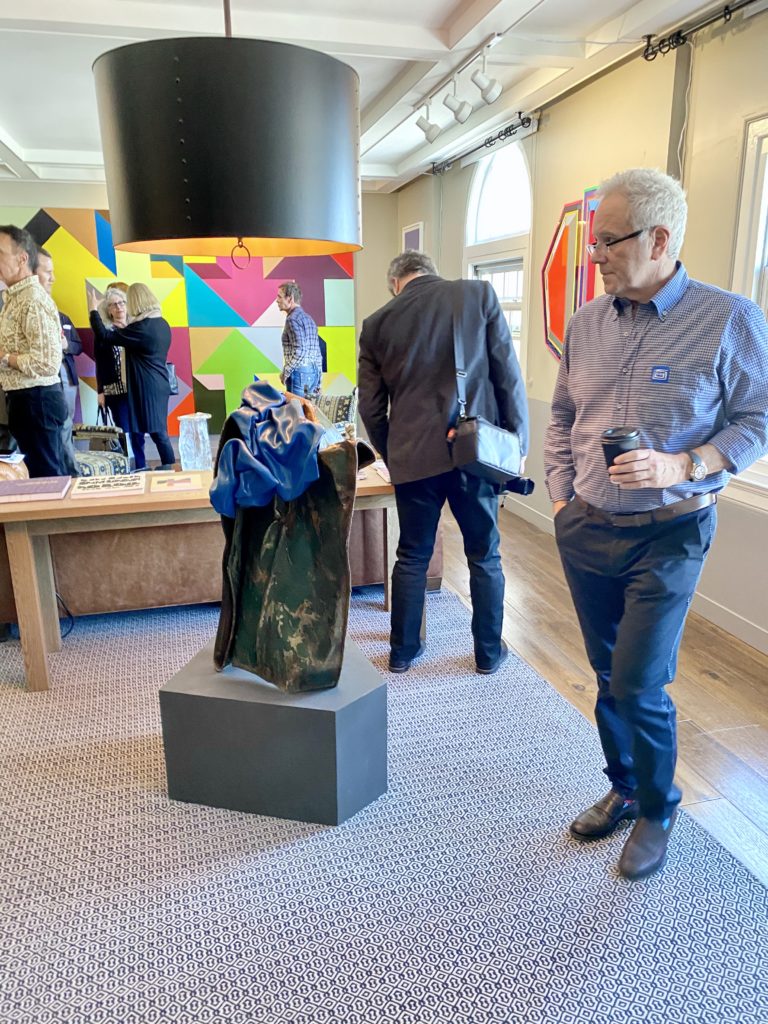
Collector and producer David Hoberman contemplates Kennedy Yanko’s sculpture Anoint (2019) inside Kavi Gupta’s booth at Felix 2020. Photography by Tim Schneider.
Rules Were Made to Be Broken
Apart from an exploratory stop at Berlin’s Galerie Barbara Weiss, Hoberman immediately headed to a quintet of galleries with whom he has longstanding relationships. Nearly all of them happened to be showing artists in his collection, too: Kim Dingle at Andrew Kreps, the immaculately named Alteronce Gumby at Los Angeles’s Parrasch Heijnen, and Vincent Valdez in the booth of young Texan-turned-Angeleno Matthew Brown.
But it wasn’t until our sixth stop—the suite occupied by Chicago mainstay Kavi Gupta—that Hoberman took his first real action. Installed beneath a central ceiling lamp was Anoint (2019), a John Chamberlain-esque sculpture by Brooklyn-based artist Kennedy Yanko. The piece combines a squat monolith of salvaged green metal with a crown of blue “paint skin” (a layer of paint dried and folded to resemble fabric), all atop a pentagonal gray plinth. Hoberman knew Yanko’s work on sight and was clearly intrigued by this particular example. “I don’t collect sculpture. It’s just about the room [it takes up],” he explained. “But I would get this piece.”
The next thing I knew, he had pivoted to gallery associate Errol Harris (who only moments earlier broke the news to Hoberman that travel complications had delayed the arrival of Gupta himself) and requested the price. Upon learning it was only $15,000, Hoberman asked the gallery to “hold it for [him] for a minute.” They exchanged information, and Hoberman was on the move again.
As we made our way to the stairway down to the 11th floor, I asked Hoberman if he came into fairs with a budget in mind. He shook his head despite himself. “No, I just bought a Fontana drawing and two other things. I should be about tapped out,” he said. “But then you never know.”
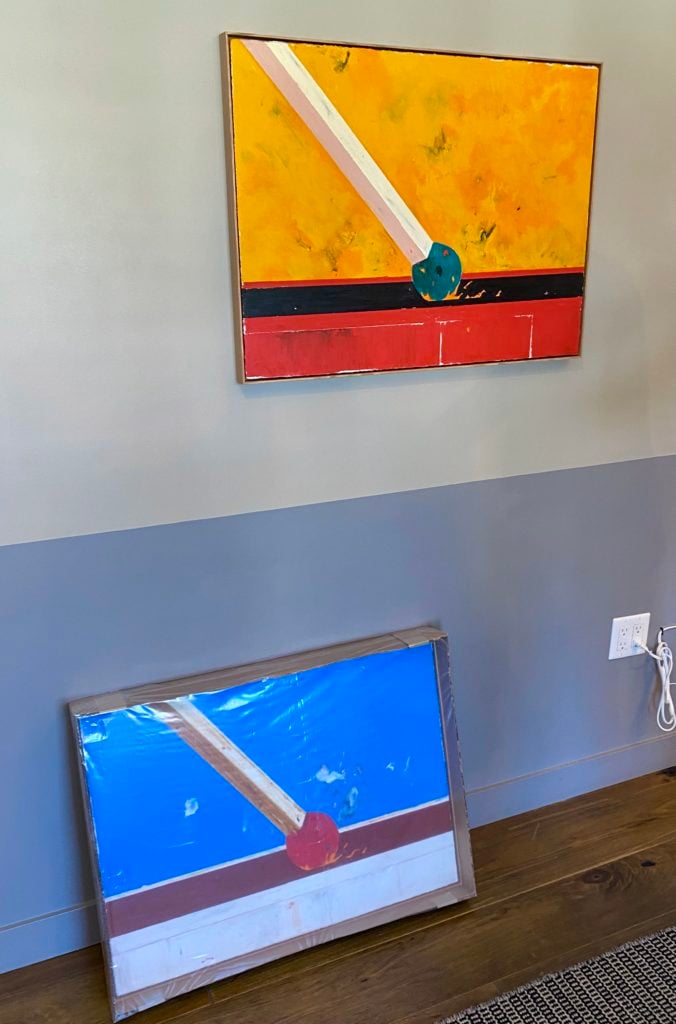
Two Harold Ancart paintings considered by David Hoberman inside the CLEARING booth at Felix 2020. (Hoberman chose the wrapped piece on the bottom.) Photography by Tim Schneider.
The Past and the Future on Floor 11
By about 11:30 a.m., navigating the 11th floor required darting between a steady stream of other VIP visitors, not just darting between rooms. But Hoberman, who dealer and artist Joel Mesler admiringly referred to later in the day as “an old-school LA collector” (meaning one who bought artwork before it was a standard trope of west-coast wealth) was undeterred.
Our next stop was the suite belonging to the highly respected New York and Brussels-based gallery CLEARING. Founder Olivier Babin greeted Hoberman warmly, and their exchange proceeded along two parallel tracks. On one hand, Babin wanted to tour Hoberman through the installation to get him interested in new work. On the other, Hoberman wanted to check up on a Harold Ancart matchstick painting he acquired from CLEARING before the fair—especially when he saw another Ancart painting featuring the same composition in a more bombastic, fiery color palette hanging inside the room.
A staffer went to fetch Hoberman’s Ancart while Babin talked him through a modestly sized painting from a new series by Sebastian Black. Using an affordable iPhone plugin, Black shoots thermal images of his cats, then paints the resulting heat maps to harness the tension between domesticated cuteness and technological unease. Hoberman listened attentively, but concluded that he wasn’t sure if it was for him, prompting Babin to pivot to a small metal wall sculpture by Koenraad Dedobbeleer and a sculptural video installation by 2019 Whitney Biennial standout Meriem Bennani in the next room.
By the time we completed the circuit and returned to the main space, Hoberman’s Ancart painting had appeared, collared in cardboard and wrapped in plastic, leaning against the same wall where its still-available counterpart was installed. He and Babin compared and contrasted the two works. While it was never explicitly said, my sense was that Hoberman had the opportunity to swap the two if he wanted. Ultimately, though, he decided he still preferred the piece he’d already committed to; the flatter, sky-blue background and white matchbox made the tiny blaze-to-be pop more distinctly.
With that matter settled, Hoberman made his way to two other favored galleries normally occupying opposite coasts. First, at Anton Kern, a director manned an iPad to scroll him through a new series of large-scale Ellen Berkenblit paintings depicting profile views of women’s faces in intense anger. The works will premier at the venerable Upper East Side gallery on February 20 in an exhibition titled “Sistergarden,” but a handful of smaller examples were installed on the Roosevelt’s ground floor as a part of Felix’s Special Projects section.
Hoberman asked the gallery to email him an image of a work described as “the big screamer” and priced at $50,000, then mentioned that he would be in New York for a shoot in the coming weeks, giving him a chance to see the Berkenblit show in person—and, he added with a mischievous grin, for the gallery to “show [him] all the Julie Curtisses.”
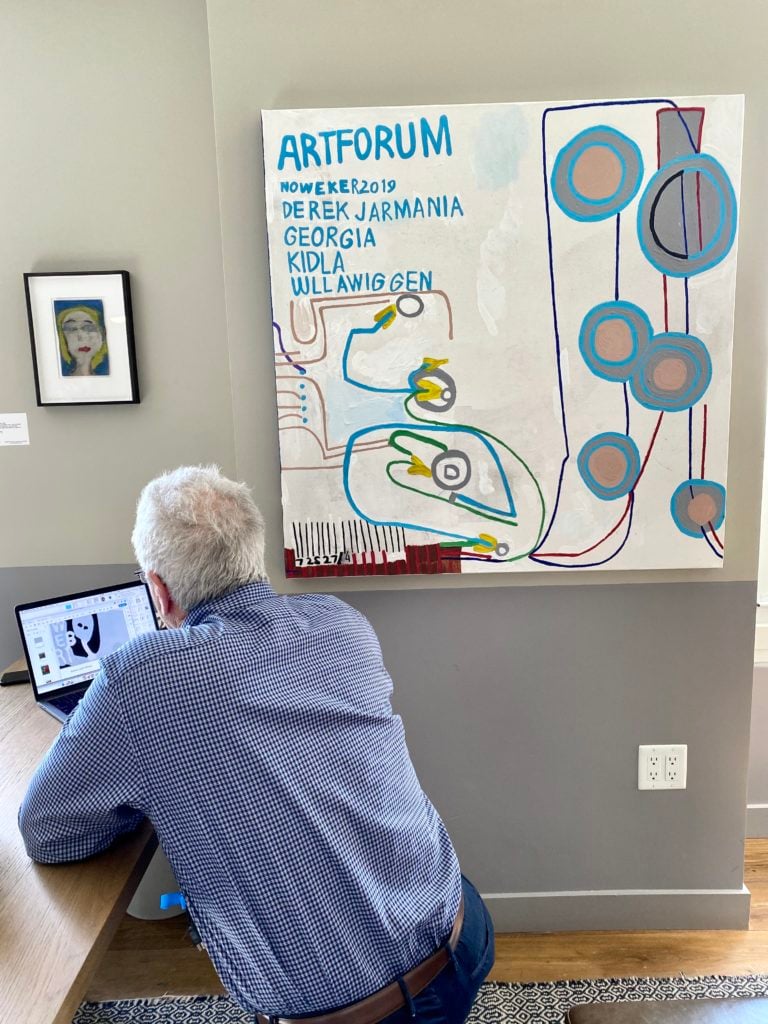
David Hoberman peruses a PDF of available works by self-taught artist Marlon Mullen (also responsible for the large painting to Hoberman’s right) inside Adams and Ollman’s booth at Felix 2020. Photography by Tim Schneider.
From there, Hoberman made his way to the room occupied by Portland’s Adams & Ollman gallery. His interest gravitated to a single large painting by Marlon Mullen, a self-taught artist active since the mid-1980s. Mullen, who has a solo show currently on view at the gallery’s permanent location, is best known for creating paintings based on magazines sourced from the library at Nurturing Independence Through Artistic Development, a California art center that mentors and empowers artists born with developmental challenges. Hoberman has been tracking Mullen for some time, and he was unmistakably excited by encountering his work at Felix.
Amy Adams, one of the gallery’s co-founders, turned her laptop over to Hoberman so that he could review Mullen’s other available paintings (priced at $5,000 to $12,000 each). He was so eager to dive in that he didn’t even bother to sit down. Instead, he took a knee like a quarterback commanding a huddle, silently devouring images and information… until he swiveled the screen towards Adams (by then talking with another visitor) and excitedly called out, “This one!”
The small digital image showed a colorful canvas based on a cover of an Artforum issue. “It’s available!” she replied happily.
But Hoberman didn’t put a hold on the work. Instead, Adams informed him that Mullen would be one of the two artists the gallery would be featuring in its presentation at the Independent art fair in New York in just over two weeks, and he wanted to see the preview before making any decisions. She promised to send him a PDF, and we departed with Hoberman visibly energized by the prospect of seeing even more work by an artist he admires.
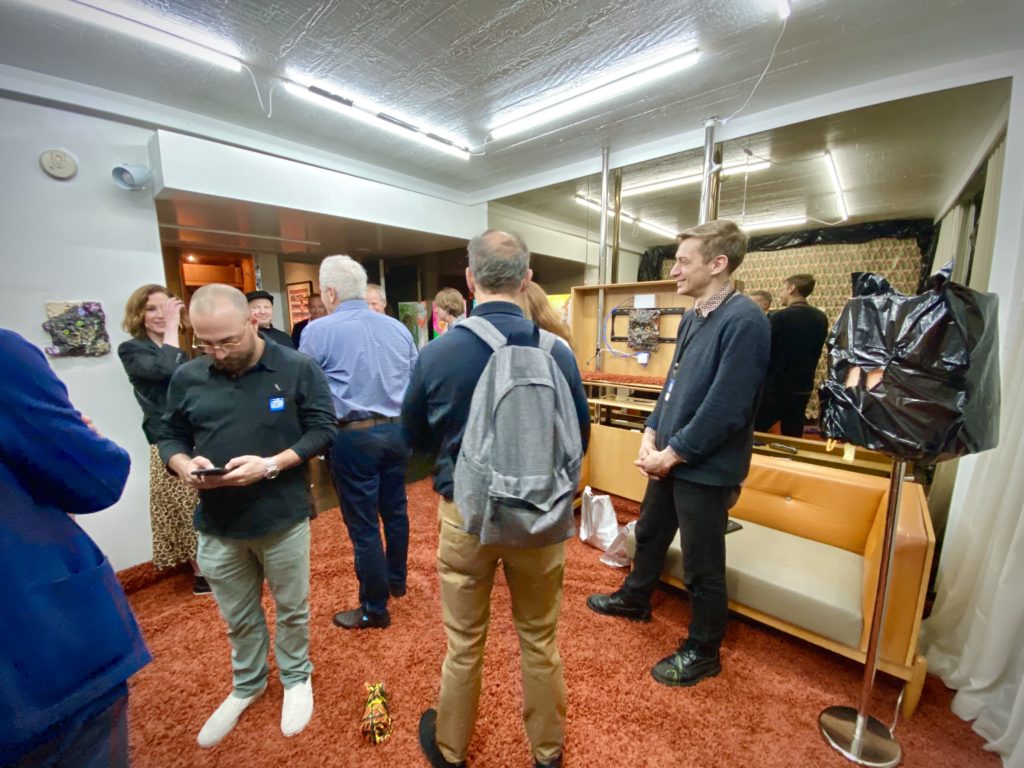
Artist Philip Hinge (right) inside his installation at Brennan & Griffin’s booth at the 2020 edition of Felix. Photography by Tim Schneider.
Collectors in Cabanas
With the line to the 11th floor’s elevator now snaking out into the hallway, Hoberman and I opted for the stairs down to the cabana level, where the last 25 exhibitors awaited. The trek gave us time to chat about his habit and its history.
“I’m the kind of guy who wants to buy everything,” he told me. “I can’t help myself.” At the same time, he estimated that his collection has not many more than 100 pieces, partly because he tries to donate about one quarter of his current holdings to institutions every year. The strategy provides him both a tax shield and enough churn to keep adding new works without being excessive.
When asked what piece has stayed in his collection longest, he said it is probably a Claes Oldenburg print he bought as a teenager. But before I could manage to get the backstory of that acquisition, we reached the ground floor, and he charged out of the stairwell with the urgency of a first responder leaping out of an ambulance—so much so that we temporarily got turned around in the bowels of the hotel and nearly ended up on the loading dock before winding our way back toward the cabanas.
With the cursed 2:30 meeting approaching, we had less than an hour before Hoberman needed to hightail it to Burbank. (It isn’t terribly far distance-wise, but actually getting from the Roosevelt to the 101 freeway during the lunch rush eats up an uglier amount of time than out-of-towners realize.) The atmosphere felt more chaotic than upstairs, but not frantic. Part of this came from the choose-your-own-adventure layout of the cabanas: more galleries than the tower floors, and more ways to get to them, since visitors could crisscross the pool area and enter cabanas from the back, in addition to rifling down the corridors leading to the front entrances. But the crowd was getting increasingly thick, which served as a reminder that, in LA and at art fairs generally, somehow practically everyone seems to be a VIP.
The first gallery Hoberman hit was that of his compatriot Nino Mier, who maintains permanent spaces in LA and Cologne. The literal centerpiece of the cabana was Ontario International Airport, a large painting by Jake Longstreth priced at $35,000: a skillfully executed, intentionally too-picture-perfect depiction of a Radisson hotel backdropped by a gradient-blue sky and an idyllic mountain range.
Hoberman recognized a “loneliness like [Edward] Hopper” in the work, but lamented that the lighting in Mier’s cabana was perhaps not doing the work justice. Mier leapt into action immediately, picking up from the floor one of the lamps lighting up the space and shining it across the work from chest level to try to improve the situation. (Never underestimate a good dealer’s willingness to do what needs to be done in pursuit of a sale.) Hoberman thanked Mier for his time and left without making any promises on the painting.
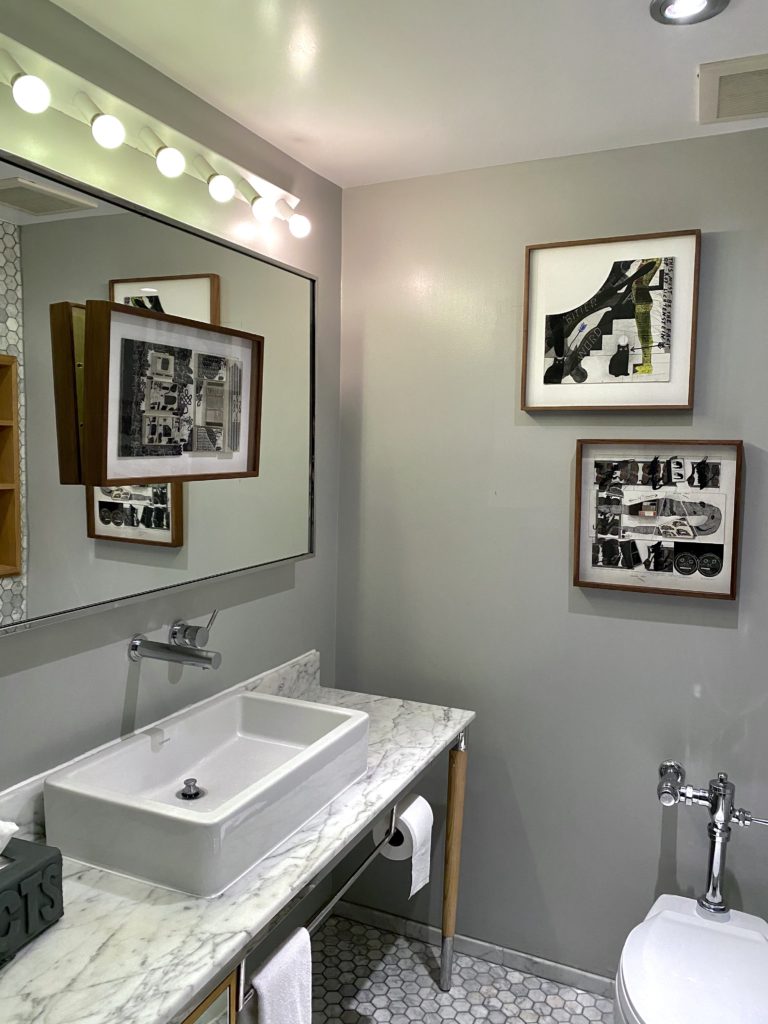
Three Ray Johnson works on paper inside the bathroom of Corbett Vs. Dempsey’s booth at Felix 2020. photography by Tim Schneider.
Instead, the work that seemed to make the biggest impression came from Chicago mainstay Corbett Vs. Dempsey, another gallery with which Hoberman has a deep comfort level. There, co-founder Jim Dempsey wowed him with three works on paper by the late collagist and mail-art progenitor Ray Johnson (all of which were installed in the bathroom). Priced from $32,000 to $34,000 each, the beguiling, largely grayscale text-and-layered-image pieces also offered a lead-in for the gallery to mention that, in 2021, it will present its first solo show with Johnson’s estate. Transfixed in the narrow space between the countertop and shower, Hoberman deemed the works “awesome” before the timer in his head started ticking too loudly to ignore any longer.
Although we went into several more cabanas afterward, it was the Johnson works that Hoberman told me struck him as perhaps the best he’d seen at Felix when we parted ways just before 1 p.m. Whether that meant he would ultimately circle back to Dempsey and his partner about acquiring one (or more) of them, I do not know. All I could say for certain after these few hours was that, if he did, it wouldn’t be because he had cut off the inflow of other possibilities. It would be because Johnson’s pull was strong enough to temporarily arrest Hoberman’s omnivorous hunger for the new.
And to think, the art market was one affordable Richard Diebenkorn painting—and one contemporary-art-evangelist confidante—away from never knowing how much of an impact Hoberman’s interest could have. It’s a twist of fate that any Hollywood executive would appreciate.
